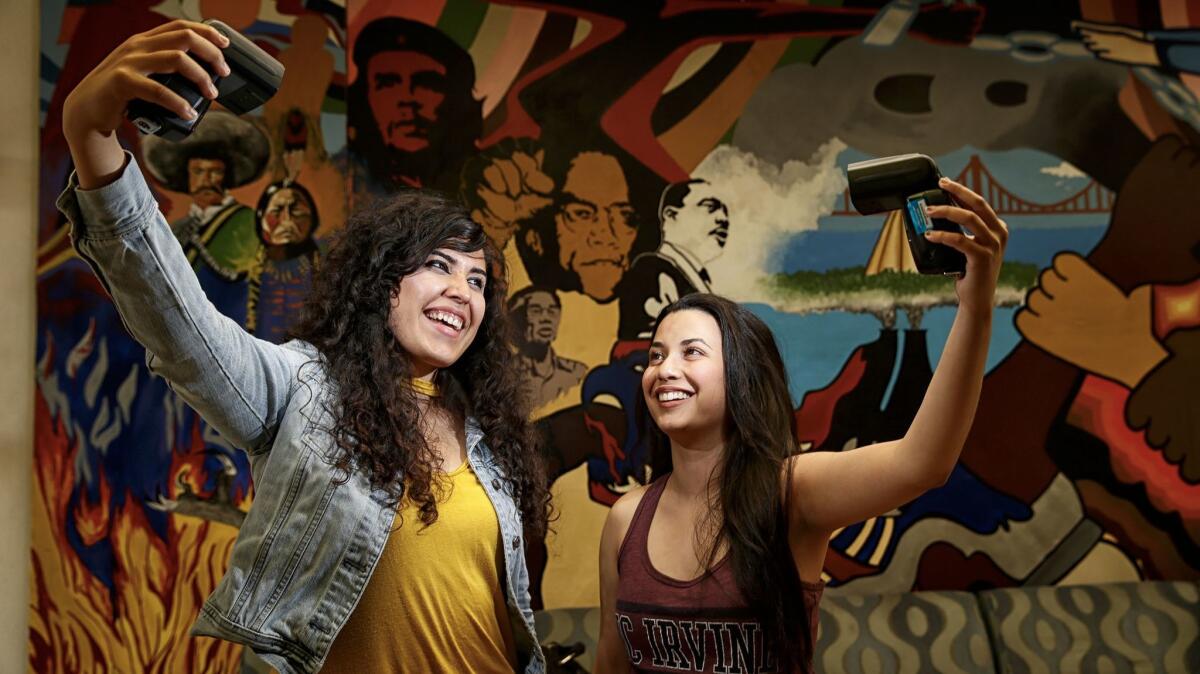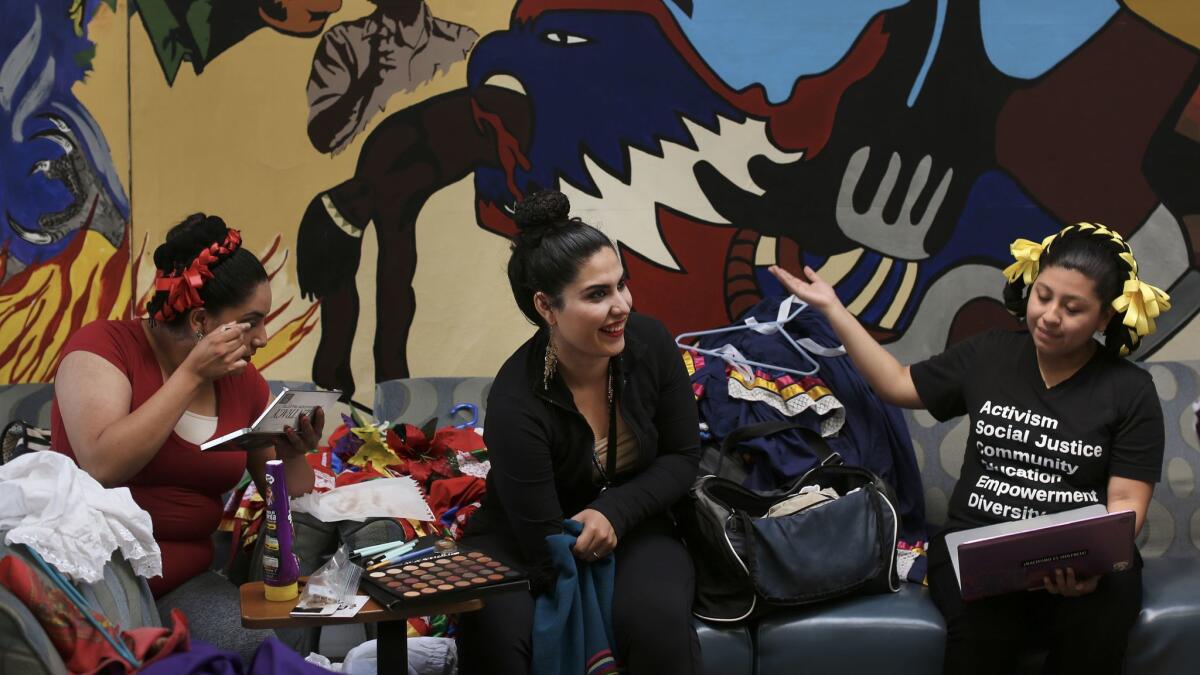UC Irvine’s rare distinction: It’s an elite research university that’s a haven for Latinos

For most of her life, Angela Vera never imagined herself at the University of California. She grew up in a low-income Santa Ana neighborhood, the daughter of a Mexico-born carpenter with second-grade schooling who stressed the value of education but didn’t know how to guide her.
“I always thought UC was for students up here,” she said, holding her hand above her head. “I never saw myself as capable.”
But after a Santa Ana College counselor encouraged her to raise her sights, Vera transferred to UC Irvine two years ago. The campus, she said, gave her the financial aid, academic support and leadership opportunities she needed to thrive — and fueled her ambitions to pursue a graduate degree after she completes a double major in criminology law and society and social ecology next year.

UC Irvine may seem an unlikely haven for Latino students. The campus is located in what used to be a largely white Republican community, home now to so many Asians that people joke that UCI stands for University of Chinese Immigrants.
But the Irvine campus is now the most popular UC choice for Latino freshmen applicants, topping longtime leader UCLA for the first time last fall. And last month the campus won federal recognition for serving Latinos — a still-rare distinction among elite research universities.
In all, 492 campuses in 19 states and Puerto Rico have been designated Hispanic Serving Institutions, which allows them to apply for about $100 million annually in federal research grants. To qualify, the campus student population must be 25% Latino, with more than half financially needy.
In California, nearly all Cal State campuses, at least half of California Community Colleges and half of UC campuses have received the recognition. But UC Irvine and UC Santa Barbara are the only HSI campuses among the 62 members of the Assn. of American Universities — an elite network of public and private research universities that includes the Ivy League, UC, Stanford and USC.
Just three of the nation’s 100 universities with the largest federal research portfolios are HSI campuses — UC Irvine ranking second to a specialized cancer center at the University of Texas, said Terry Hartle, senior vice president of the American Council on Education, which represents 1,600 colleges and universities.

“One concern about major research universities is that they don’t necessarily look like the population of the United States,” Hartle said. “They are overrepresented with whites and Asians and underrepresented with African Americans and Hispanics.
“What you’re seeing at UC Irvine … is a conscious decision to make certain they expand the nature of the population they’re serving.”
UC Irvine Chancellor Howard Gillman said the campus has pushed to diversify its campus as part of its public mission and urged other top institutions to do the same.
“We think it’s important to show that great higher education can be there for all of the people,” he said. “The demographics of the state are changing, and great institutions that were there for generations past should also be there for generations of the future.”
For the first time ever, more than half of UC Irvine’s graduating class this year are first-generation college students.
UC Irvine, Gillman said, is not only admitting more Latino students but also helping them succeed. Eight of 10 freshmen who entered in 2010-11 graduated within six years, about equal to whites and blacks and just below Asians. Graduation rates for transfer students are even higher.
Success took time. The campus began laying the groundwork in 1983, when it created the Santa Ana Partnership with local schools, Santa Ana College and Cal State Fullerton to improve college-going rates in the area. It intensified the efforts after state voters in 1996 passed Proposition 209 banning race-based affirmative action, said Stephanie Reyes-Tuccio, executive director of the Center for Educational Partnerships.
One concern about major research universities is that they don’t necessarily look like the population of the United States.
— Terry Hartle, senior vice president of the American Council on Education
The center serves 12,000 largely low-income students a year, three-fourths of them Latino, with programs to prepare them for college and help them succeed. It supports those interested in science, technology, engineering and math and helped develop a college-going plan for every high school student in the Santa Ana Unified School District. Affiliated faculty also conduct research and offer teacher training.
About 85% of high school students who work with the center complete the college prep coursework required for UC and Cal State, compared with the statewide average of 43%, Reyes-Tuccio said. She raises about three-fourths of her $10-million annual budget from public grants, private gifts.
Several Latino students said they chose UC Irvine because of generous financial aid and proximity to their families in surrounding cities. But many said they experienced culture shock moving from largely Latino neighborhoods and schools to the university, where only a quarter of students share their ethnic background.
Gloria Ochoa and David Cosme, both transfer students from Mt. San Antonio College in Walnut, said they initially were taken aback by conservative student rallies against immigrants and Muslims, featuring signs such as “Build That Wall” and “You’re Not Welcome Here.”
“I was wondering if I chose the right school,” said Cosme, a third-year sociology major who was born in Mexico and is the first in his family to attend college. “I wondered if I would fit in. Would I have to hide my identity?”
But he and Ochoa said they soon discovered supportive faculty and staff, more than 25 Latino student organizations and campus centers offering many support services.
Cosme found a comfort zone volunteering with the campus food pantry and a Chicano student organization, MEChA. “UCI provides a lot of spaces for my community to feel safe and express ourselves,” he said.
Ochoa, a third-year psychology and social behavior major, said she was amazed by the offerings at the Cross-Cultural Center, where she attended a workshop on trans Latina activism. Her disappointment at being wait-listed at UCLA vanished, she said, when she discovered the rich research opportunities at UC Irvine, where she is applying for positions to study autism and developmental disabilities.
“One great thing about UCI that they don’t get a lot of recognition and credit for is that a lot of faculty do research and there are so many labs to apply to,” Ochoa said.
Stephanie Gonzalez, 22, discovered her “family” as she calls it, at the Student Outreach and Retention Center, where she was able to find friends, leadership opportunities and food — peanut butter and jelly sandwiches that eased hunger pains since she could not afford a campus meal plan. She was hired by the center to develop mentorship programs and trained peer advisers to help students through such hardships as homesickness, breakups and academic struggles.
Daniela Estrada, daughter of a cook and hospital worker from Mexico, credited much of her success to campus mentors.
A counselor with the SAGE Scholars program for academically gifted, low-income students helped her craft a resume that landed her a law firm job when she thought she was unqualified. Mark Petracca, the associate dean for undergraduate studies in the School of Social Sciences, passed along research opportunities and nominated her for the prestigious Truman Scholarship, which provides up to $30,000 for graduate studies leading to a public service job. She plans to attend law school to become a public defender after completing a Fulbright program teaching English in Colombia.
“Professor Petracca changed my experience and trajectory and future by believing in me more than I did in myself,” said Estrada, a political science major who will graduate this month. “That’s what so many students want: someone to believe in them.”
UC Irvine’s performance reviews reward faculty who contribute to “inclusive excellence.” The campus has created a database to connect faculty to opportunities to advance diversity and equity and has set a goal for at least half of them to be involved by 2020-21.
Some students said the campus could do more — offer more scholarships, for instance, and expand the food pantry. Administrators say they aim to do both with more funding opportunities as an HSI campus. A few students said they were being marginalized by a plan to relocate space for immigrant and LGBTQ students to a less central part of campus, although a university spokesman said the facilities will be upgraded and more spacious.
As for Vera, UC Irvine gave her a full ride and a chancellor’s scholarship to volunteer in Peru. She has found friends and a way to express her cultural identity, especially dancing for the Ballet Folklórico de UCI.
The once insecure Latina who never dreamed she could attend UC Irvine is now its irrepressible evangelist.
To read the article in Spanish, click here
Twitter: @teresawatanabe
ALSO
Second person convicted in fatal beating of USC graduate student
Most private colleges take very few transfers. At USC, about 1,500 get a spot each year
More to Read
Sign up for Essential California
The most important California stories and recommendations in your inbox every morning.
You may occasionally receive promotional content from the Los Angeles Times.










